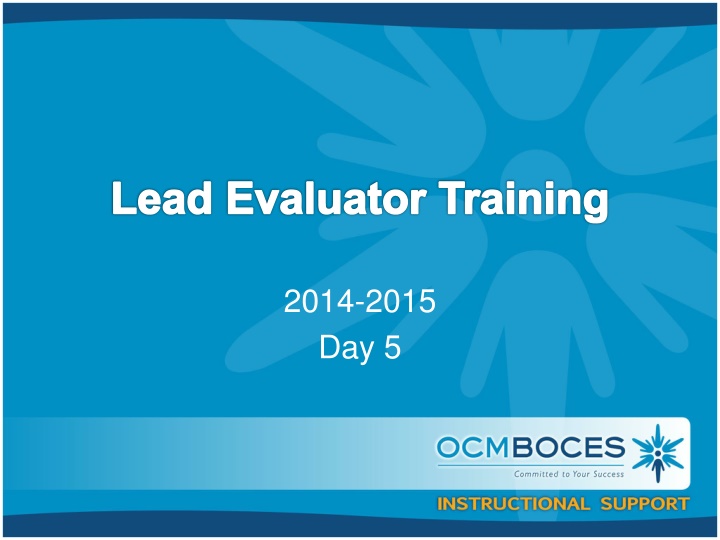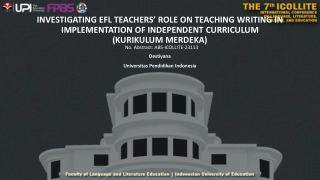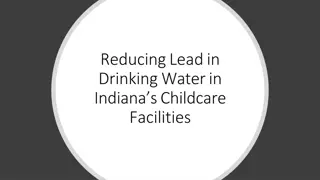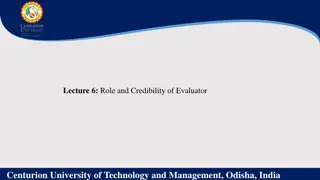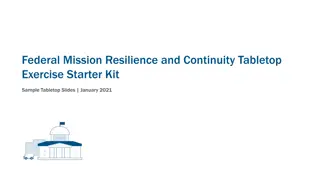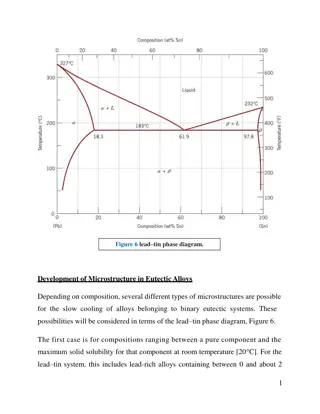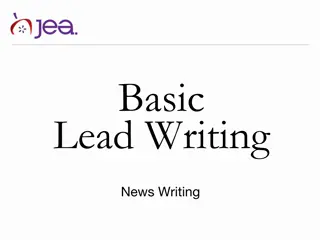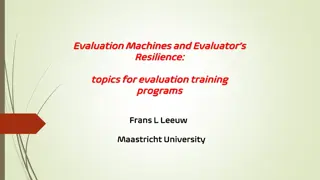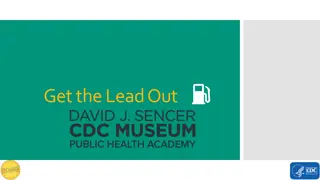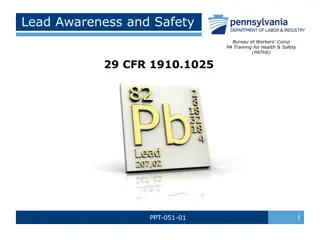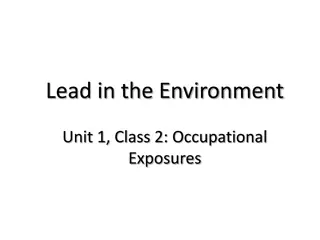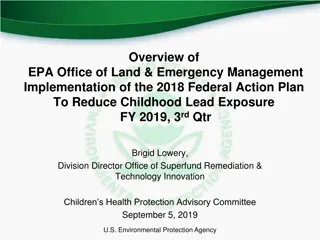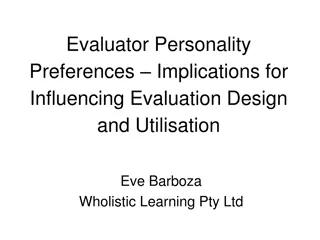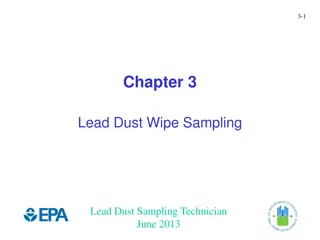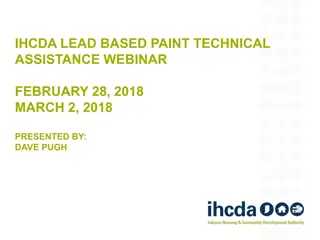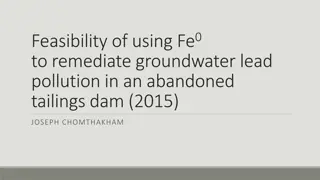Lead Evaluator Training
Explore the agenda and activities of Lead Evaluator Training 2014-2015 Day 5. Dive into topics like ELA/Literacy shifts, observation techniques, warm-up exercises, and valuable messages for educators. Enhance your understanding of educational practices and student engagement.
Download Presentation

Please find below an Image/Link to download the presentation.
The content on the website is provided AS IS for your information and personal use only. It may not be sold, licensed, or shared on other websites without obtaining consent from the author.If you encounter any issues during the download, it is possible that the publisher has removed the file from their server.
You are allowed to download the files provided on this website for personal or commercial use, subject to the condition that they are used lawfully. All files are the property of their respective owners.
The content on the website is provided AS IS for your information and personal use only. It may not be sold, licensed, or shared on other websites without obtaining consent from the author.
E N D
Presentation Transcript
Lead Evaluator Training 2014-2015 Day 5
Agenda What have you been up to? Sharing what we ve done related to this work in the last month. A little more on the Six shifts in ELA/Literacy Technical v. Personal Observation > Evidence Collection > Label > Sort > Rubric Another mini-observation and follow-up conversation
Warming up: Organize the blue cards. Constructivism 21st Century Skills Cognitive engagement Validity 3
Warming up: Now integrate the yellow cards into your scheme. Continuous Improvement 4
The essential message is not you are broken and I m here to fix you but instead you are so valuable and worthy, our mission so vital, the future lives of our students so precious, that we have a joint responsibility to each other. -Doug Reeves 6
ELA/Literacy and the Common Core
Six Shifts: ELA/Literacy Balancing Informational & Literary Texts (Grades PK-5) Knowledge in the Disciplines (Grades 6-12) Staircase of Complexity Text-based Answers Writing from Sources Academic Vocabulary
Staircase of Complexity Interquartile Ranges Shown (25% - 75%) 1600 1400 Text Lexile Measure (L) 1200 1000 800 600 High School Literature College Textbooks Military High School Textbooks Personal Use Entry-Level Occupations SAT 1, ACT, AP* College Literature * Source of National Test Data: MetaMetrics
Shift 1: Balancing Informational and Literary Text What the Student Does Build background knowledge to increase reading skill Exposure to the world through reading Apply strategies to reading informational text. What the Teacher Does Provide students equal #s of informational and literary texts Ensure coherent instruction about content Teach strategies for informational texts Teach through and with informational texts Scaffold for the difficulties that informational text present to students Ask students, What is connected here? How does this fit together? What details tell you that? What the Principal Does Purchase and provide equal amounts of informational and literacy text to students Hold teachers accountable for building student content knowledge through text Provide PD and co- planning opportunities for teachers to become more intimate with non fiction texts and the way they spiral together
Shift 1: Balancing Informational and Literary Text What the Student Does Build background knowledge to increase reading skill Exposure to the world through reading Apply strategies to reading informational text. What the Teacher Does Provide students equal #s of informational and literary texts Ensure coherent instruction about content Teach strategies for informational texts Teach through and with informational texts Scaffold for the difficulties that informational text present to students Ask students, What is connected here? How does this fit together? What details tell you that? What the Principal Does Purchase and provide equal amounts of informational and literacy text to students Hold teachers accountable for building student content knowledge through text Provide PD and co- planning opportunities for teachers to become more intimate with non fiction texts and the way they spiral together
Shift 2: Knowledge in the Disciplines What the Student Does Become better readers by building background knowledge Handle primary source documents with confidence Infer, like a detective, where the evidence is in a text to support an argument or opinion See the text itself as a source of evidence (what did it say vs. what did it not say?) What the Teacher Does Shift identity: I teach reading. Stop referring and summarizing and start reading Slow down the history and science classroom Teach different approaches for different types of texts Treat the text itself as a source of evidence Teach students to write about evidence from the text Teach students to support their opinion with evidence. Ask : How do you know? Why do you think that? Show me in the text where you see evidence for your opinion. What the Principal Does Support and demand the role of all teachers in advancing students literacy Provide guidance and support to ensure the shift to informational texts for 6-12 Give teachers permission to slow down and deeply study texts with students 12
Shift 2: Knowledge in the Disciplines What the Student Does Become better readers by building background knowledge Handle primary source documents with confidence Infer, like a detective, where the evidence is in a text to support an argument or opinion See the text itself as a source of evidence (what did it say vs. what did it not say?) What the Teacher Does Shift identity: I teach reading. Stop referring and summarizing and start reading Slow down the history and science classroom Teach different approaches for different types of texts Treat the text itself as a source of evidence Teach students to write about evidence from the text Teach students to support their opinion with evidence. Ask : How do you know? Why do you think that? Show me in the text where you see evidence for your opinion. What the Principal Does Support and demand the role of all teachers in advancing students literacy Provide guidance and support to ensure the shift to informational texts for 6-12 Give teachers permission to slow down and deeply study texts with students 13
Shift 3: Staircase of Complexity What the Student Does What the Teacher Does What the Principal Does Read to see what more they can find and learn as they re- read texts again and again Read material at own level to build joy of reading and pleasure in the world Be persistent despite challenges when reading; good readers tolerate frustration Ensure students are engaged in more complex texts at every grade level Engage students in rigorous conversation Provide experience with complex texts Give students less to read, let them re-read Use leveled texts carefully to build independence in struggling readers More time on more complex texts Provide scaffolding Engage with texts w/ other adults Get kids inspired and excited about the beauty of language Ensure that complexity of text builds from grade to grade. Look at current scope and sequence to determine where/how to incorporate greater text complexity Allow and encourage teachers to build a unit in a way that has students scaffold to more complex texts over time Allow and encourage teachers the opportunity to share texts with students that may be at frustration level 14
Shift 3: Staircase of Complexity What the Student Does What the Teacher Does What the Principal Does Read to see what more they can find and learn as they re- read texts again and again Read material at own level to build joy of reading and pleasure in the world Be persistent despite challenges when reading; good readers tolerate frustration Ensure students are engaged in more complex texts at every grade level Engage students in rigorous conversation Provide experience with complex texts Give students less to read, let them re-read Use leveled texts carefully to build independence in struggling readers More time on more complex texts Provide scaffolding Engage with texts w/ other adults Get kids inspired and excited about the beauty of language Ensure that complexity of text builds from grade to grade. Look at current scope and sequence to determine where/how to incorporate greater text complexity Allow and encourage teachers to build a unit in a way that has students scaffold to more complex texts over time Allow and encourage teachers the opportunity to share texts with students that may be at frustration level 15
Shift 4: Text Based Answers What the Student Does What the Teacher Does What the Principal Does Go back to text to find evidence to support their argument in a thoughtful, careful, precise way Develop a fascination with reading Create own judgments and become scholars, rather than witnesses of the text Conducting reading as a close reading of the text and engaging with the author and what the author is trying to say Facilitate evidence based conversations with students, dependent on the text Have discipline about asking students where in the text to find evidence, where they saw certain details, where the author communicated something, why the author may believe something; show all this in the words from the text. Plan and conduct rich conversations about the stuff that the writer is writing about. Keep students in the text Identify questions that are text- dependent, worth asking/exploring, deliver richly, Provide students the opportunity to read the text, encounter references to another text, another event and to dig in more deeply into the text to try and figure out what is going on. Spend much more time preparing for instruction by reading deeply. Allow teachers the time to spend more time with students writing about the texts they read- and to revisit the texts to find more evidence to write stronger arguments. Provide planning time for teachers to engage with the text to prepare and identify appropriate text-dependent questions. Create working groups to establish common understanding for what to expect from student writing at different grade levels for text based answers. Structure student work protocols for teachers to compare student work products; particularly in the area of providing evidence to support arguments/conclusions. 16
Shift 4: Text Based Answers What the Student Does What the Teacher Does What the Principal Does Go back to text to find evidence to support their argument in a thoughtful, careful, precise way Develop a fascination with reading Create own judgments and become scholars, rather than witnesses of the text Conducting reading as a close reading of the text and engaging with the author and what the author is trying to say Facilitate evidence based conversations with students, dependent on the text Have discipline about asking students where in the text to find evidence, where they saw certain details, where the author communicated something, why the author may believe something; show all this in the words from the text. Plan and conduct rich conversations about the stuff that the writer is writing about. Keep students in the text Identify questions that are text- dependent, worth asking/exploring, deliver richly, Provide students the opportunity to read the text, encounter references to another text, another event and to dig in more deeply into the text to try and figure out what is going on. Spend much more time preparing for instruction by reading deeply. Allow teachers the time to spend more time with students writing about the texts they read- and to revisit the texts to find more evidence to write stronger arguments. Provide planning time for teachers to engage with the text to prepare and identify appropriate text-dependent questions. Create working groups to establish common understanding for what to expect from student writing at different grade levels for text based answers. Structure student work protocols for teachers to compare student work products; particularly in the area of providing evidence to support arguments/conclusions. 17
Shift 5: Writing from Sources What the Student Does What the Teacher Does What the Principal Does Begin to generate own informational texts Expect that students will generate their own informational texts (spending much less time on personal narratives) Present opportunities to write from multiple sources about a single topic. Give opportunities to analyze, synthesize ideas across many texts to draw an opinion or conclusion. Find ways to push towards a style of writing where the voice comes from drawing on powerful, meaningful evidence. Give permission to students to start to have their own reaction and draw their own connections. Build teacher capacity and hold teachers accountable to move students towards informational writing 18
Shift 5: Writing from Sources What the Student Does What the Teacher Does What the Principal Does Begin to generate own informational texts Expect that students will generate their own informational texts (spending much less time on personal narratives) Present opportunities to write from multiple sources about a single topic. Give opportunities to analyze, synthesize ideas across many texts to draw an opinion or conclusion. Find ways to push towards a style of writing where the voice comes from drawing on powerful, meaningful evidence. Give permission to students to start to have their own reaction and draw their own connections. Build teacher capacity and hold teachers accountable to move students towards informational writing 19
Shift 6: Academic Vocabulary What the Student Does Does What the Teacher What the Principal Does Spend more time learning words across webs and associating words with others instead of learning individual, isolated vocabulary words. Provide training to teachers on the shift for teaching vocabulary in a more meaningful, effective manner. Develop students ability to use and access words that show up in everyday text and that may be slightly out of reach Be strategic about the kind of vocabulary you re developing and figure out which words fall into which categories- tier 2 vs. tier 3 Determine the words that students are going to read most frequently and spend time mostly on those words Teach fewer words but teach the webs of words around it Shift attention on how to plan vocabulary meaningfully using tiers and transferability strategies 20
Shift 6: Academic Vocabulary What the Student Does Does What the Teacher What the Principal Does Spend more time learning words across webs and associating words with others instead of learning individual, isolated vocabulary words. Provide training to teachers on the shift for teaching vocabulary in a more meaningful, effective manner. Develop students ability to use and access words that show up in everyday text and that may be slightly out of reach Be strategic about the kind of vocabulary you re developing and figure out which words fall into which categories- tier 2 vs. tier 3 Determine the words that students are going to read most frequently and spend time mostly on those words Teach fewer words but teach the webs of words around it Shift attention on how to plan vocabulary meaningfully using tiers and transferability strategies 21
Divide 100% of your staff between: % of your staff who have had an introduction to the 6 shifts in ELA/Literacy and been told that it applies to them in some way % of your staff who have started to do something about the 6 shifts in ELA/Literacy when it comes to their planning and instruction % of your staff who have internalized that the 6 shifts in ELA/Literacy require some amount of change in their practice % of your staff who embraced the 6 shifts and who are regularly making changes to their planning and instruction % of your staff who have heard of the Common Core but not the 6 shifts in ELA/Literacy What is your next step(s)?
Growth-Producing Feedback
The Year at a Glance Ongoing End of the Year Beginning of the Year Beginning of the year meeting Standards I and II SLO and local (LAT) target setting Evidence Submission by Teacher Evidence Collection Sharing the evidence Feedback Conversations Evidence from the year collected Compare collected evidence to the rubric Summative score determination and communication
Conversation, Questions & Discussion Respect & Rapport COLLECT DATA (Evidence) Conclusions Impact on learning Support needed
Checking in with Kim Read what Kim has to say about feedback to teachers Discuss as a table group: how does his advice compare to your walkthrough/mini experiences? 27
Evidence Collection and Growth-Producing Feedback
ELA Classroom Observe what the teacher and the students are doing in this lesson (excerpt) Collect evidence electronically Label it by NYS Teaching Standard or Domain Sort it Compare with your neighbor/table
Rubric as Road Maps Identify your destination Identify your current location Design the best route to your destination and move forward NOT as inspection tools 30
Evidence and a Rubric Individually, review the evidence and the slice of the rubric. What would be your opening line with the teacher? How might the teacher reply? Now, score the rubric (together). Plan the opening line and anticipate the teacher s response. Any difference? Element 3.2: Teacher communicates clearly and accurately with students to maximize their understanding and learning. NYSED Indicators: Students understand directions and procedures. Teachers use a variety of questioning techniques to advance student learning and reflection. Students comments and questions are acknowledged and utilized to advance learning. Students understand lesson content through teachers use of oral, written and graphic methods. Adjust communication in response to student needs. Indicators Ineffective Developing A. Provides directions and procedures adjust explanation to meet student needs. explanations to meet student needs. Effective Highly Effective Teacher directions and procedures are clear, complete, and anticipate possible student misunderstanding. Teacher adjusts explanations to meet the needs of individual students. Teacher s questions are open in nature and challenge students to think and demonstrate reasoning. Students formulate many questions to advance their understanding. Teacher and students respond to students questions/comments. Responses challenge all students thinking. Teacher s spoken and written language is correct and expressive. Graphic methods are used regularly to enhance content understanding. Students offer their own graphic representation of the content. Teacher directions and procedures are confusing to students. Teacher does not Teacher directions and procedures are clarified after initial student confusion. Teacher attempts to adjust Teacher directions and procedures are clear to students. Teacher adjusts explanations to meet student needs. B. Uses questioning techniques Teacher s questions are largely closed in nature. Questions do not invite a thoughtful response or further discussion. Teacher s questions are a combination of open and closed questions. Some questions invite a thoughtful response and/or further discussion. Most of teacher s questions are open in nature and engage students in deeper thinking and further discussion. Responds to students C. Teacher responds to some students questions/comments. Response gives students the answer rather than challenge student thinking. Teacher s spoken language is audible, and written language is legible. Both are used correctly. Graphic methods are used occasionally. Teacher ignores students questions/comments and/or provides a response that shuts down student learning. Teacher responds to students questions/comments. Responses challenge student thinking. Communicates content D. Teacher s spoken language is inaudible, and/or written language is illegible. Spoken or written language contains errors. Graphic methods are not used or used ineffectively. Teacher s spoken and written language is clear and correct. Graphic methods are used regularly to enhance content understanding. Collected Evidence: Teacher called on students who raised their hand. Teacher asked: Who wrote the piece we just listened to? Teacher asked: In which period does this piece belong? When student answered incorrectly she called on another volunteer. Teacher asked: How do you know? Teacher finished student s explanation for her. Teacher asked: What other pieces we have heard does this remind you of? Teacher told students to draw a picture of which season the music reminded them. Teacher told student who didn t have anything to write with to borrow from a neighbor. When one table group wasn t doing drawing, teacher came over, repeated directions, and students went to work. Teacher called on volunteers to share their drawing with the class. Teacher called on some students once and some twice; those who didn t raise their hand were not called on at all 31
Growth-Producing Feedback With your neighbor, plan your conversation with the teacher
Next Session October 28th in Syracuse Agenda will include Math mini-lesson Evidence Collection Growth-Producing Feedback
